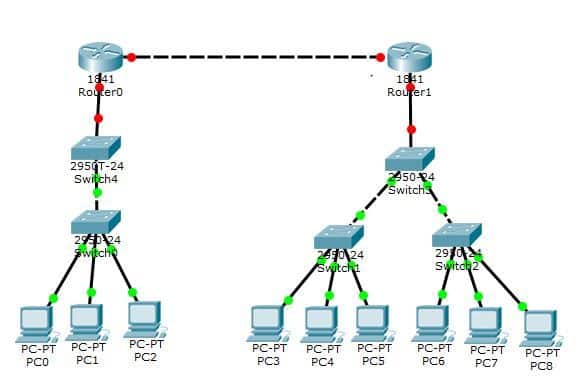In the world of computer networks, efficient and secure data transmission is of paramount importance. The collision domain is a concept that plays a vital role in ensuring smooth and reliable communication within a network.
In this article, we will delve into the collision domain, its significance, and how it influences network performance.
So, let’s embark on this journey to explore the fascinating world of network traffic segmentation!
Introduction to Collision Domain

In computer networking, a collision domain refers to a network segment or a portion of a network in which network devices share the same communication channel.
In simpler terms, it is a scenario where two or more devices try to transmit data simultaneously, resulting in a collision and the loss of transmitted data packets.
Understanding collision domains is essential for designing and managing efficient and reliable networks.
How Collision Domain Works
In a network without collision domain segmentation, multiple devices connected to a shared communication medium, such as an Ethernet cable, contend for the same channel when transmitting data.
When two or more devices attempt to transmit simultaneously, a collision occurs, and the data sent by each device becomes corrupted.
To minimize collisions and improve network performance, collision domain segmentation is implemented.
Collision Domain and Ethernet Networks
Ethernet networks, which are widely used in both local area networks (LANs) and wide area networks (WANs), rely on the concept of collision domains.
In Ethernet, a collision domain consists of all the devices connected to a shared physical medium, such as an Ethernet switch or hub. Each collision domain has its own unique network address and experiences collisions only within its boundaries.
Benefits of Network Traffic Segmentation
Segmenting network traffic into collision domains offers several benefits. Firstly, it reduces the chances of collisions and thereby increases the overall efficiency of data transmission.
By limiting the collision domain size, network administrators can minimize the number of devices contending for the same communication channel.
Additionally, segmentation enhances network security by isolating sensitive or critical data traffic from other parts of the network.
Collision Domain Limitations
While collision domain segmentation brings numerous advantages, it also has certain limitations. As the number of collision domains increases, the complexity of network management and configuration also rises.
Administrators must carefully plan and implement collision domain segmentation to avoid unnecessary complications.
Moreover, the physical distance between devices within a collision domain can impact network latency and performance.
Strategies for Collision Domain Management
To effectively manage collision domains, network administrators employ various strategies. One common approach is the use of network switches instead of hubs. Switches provide dedicated communication channels for connected devices, effectively reducing collisions.
VLANs (Virtual Local Area Networks) are another popular technique for collision domain management. VLANs allow the logical segmentation of a network, isolating traffic within defined boundaries.
Implementing Collision Domain Segmentation
To implement collision domain segmentation, network administrators can use physical or logical methods. Physical segmentation involves the use of physical devices, such as switches or routers, to create separate collision domains.
Logical segmentation, on the other hand, utilizes VLANs or other network virtualization techniques to achieve the same goal without requiring additional hardware.
The choice between physical and logical segmentation depends on the network infrastructure and specific requirements.
Impact of Collision Domain on Network Performance
The collision domain has a significant impact on network performance. By reducing the size of collision domains, administrators can minimize the likelihood of collisions, resulting in improved data transmission rates. Smaller collision domains also lead to reduced network congestion and latency.
Additionally, efficient collision domain management ensures that network resources are utilized optimally, enhancing overall network performance.
Collision Domain and Network Security
Network security is a critical concern in today’s digital landscape. Collision domain segmentation plays a crucial role in network security by isolating different types of traffic.
By segregating sensitive data traffic from general traffic, administrators can implement security measures more effectively.
For example, sensitive data traffic can be encrypted or monitored more closely within its dedicated collision domain, adding an extra layer of protection.
Collision Domain in Wireless Networks
Collision domain segmentation is not limited to wired networks; it is equally important in wireless networks. In wireless networks, multiple devices communicate over the same frequency spectrum.
Collision domain management becomes crucial to prevent data collisions and ensure reliable wireless communication.
Techniques like CSMA/CA (Carrier Sense Multiple Access with Collision Avoidance) are employed to mitigate collisions in wireless environments.
The Future of Collision Domain
As networks continue to evolve, collision domain management will remain an important aspect of network design and optimization.
With the rise of IoT (Internet of Things) and the increasing number of connected devices, efficient collision domain segmentation becomes even more critical.
Network administrators will need to adapt to changing technologies and implement effective collision domain strategies to ensure seamless and secure network communication.
Conclusion
In conclusion, understanding collision domains is crucial for building efficient and secure computer networks. Collision domain segmentation plays a vital role in reducing collisions, improving network performance, and enhancing network security.
By implementing strategies like network switches, VLANs, and logical segmentation techniques, network administrators can effectively manage collision domains and optimize data transmission.
As technology advances, collision domain management will continue to evolve, shaping the future of network communication.
FAQs
1. What is a collision domain?
A collision domain refers to a network segment where devices share the same communication channel and contend for transmission, potentially resulting in data collisions.
2. How does collision domain segmentation improve network performance?
By reducing the size of collision domains, collision domain segmentation minimizes collisions, enhances data transmission rates, and reduces network congestion and latency.
3. Can collision domain segmentation improve network security?
Yes, collision domain segmentation isolates different types of traffic, allowing administrators to implement security measures more effectively and protect sensitive data.
4. What are some strategies for collision domain management?
Strategies for collision domain management include using network switches, implementing VLANs, and employing logical segmentation techniques.
5. Is collision domain segmentation relevant in wireless networks?
Yes, collision domain segmentation is equally important in wireless networks to prevent data collisions and ensure reliable wireless communication.



